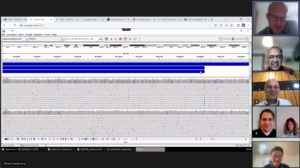As common genetic testing methodologies cannot detect copy-neutral rearrangements such as inversions, this category of variant suffers from under-ascertainment. Pagnamenta and colleagues scanned data from the 100KGP (#genomes100k) for 43 genes linked to skeletal disorders. Ten individuals from 3 families harboured diagnostic inversions. In two families, GLI3-disrupting inversions segregated with skeletal features consistent with Greig syndrome. For one case, blending was due to the opposing breakpoint lying near HOX13. In the third family, long suspected to have Marfan syndrome, the inversion disrupted FBN1. These findings resolved diagnostic odysseys of 9-20 years, extend the mutational spectra linked to these conditions and informs future prioritisation strategies within the NHS Genomic Medicine Service. (By Dr. Alistair T Pagnamenta, https://jmg.bmj.com/content/early/2022/11/21/jmg-2022-108753 )
Alistair, Sarj, Jing, Jenny, Kassim and Mohamed reviewing genomic data for F2 and F3
